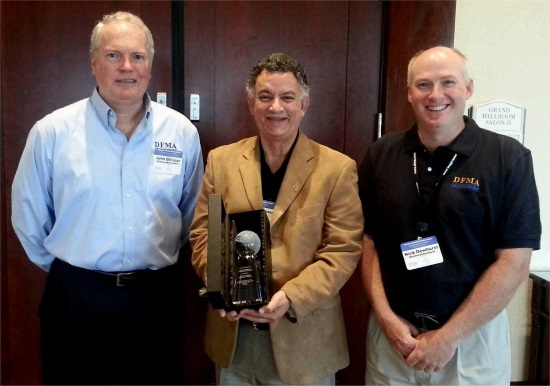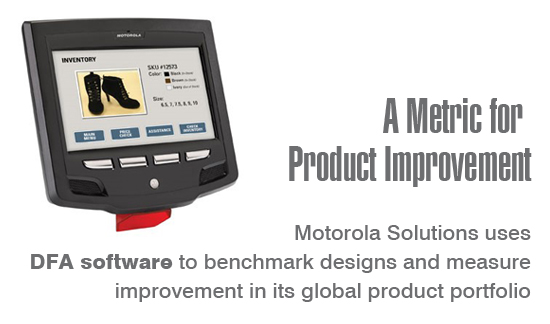

Now there’s a real question! And there are several ways to answer. Cost and price are often treated the same in traditional bidding. Three suppliers give a price and the OEM applies downward pressure until supplier resistance finally produces a “cost” that is agreed upon. Late-stage engineering decisions; inconsistent collaboration between design, purchasing and management; and strict market release dates all conspire to take time away from a more deliberate review of the true, underlying product-cost structure.
In search of the cost of that price, more companies are indeed using DFM Concurrent Costing to better analyze charges by suppliers and open fruitful discussions. Yet the software tool is still frequently applied solely for supplier price negotiations. This aids the process outlined in the first paragraph—but is something still missing?
In an age when so much is riding on securing profit margins (and effectively managing the whole development stream, too), it’s worth remembering that in the end we are paying for functions, not parts. Parts are only there to facilitate essential functions that either consumers or industries value and will pay for.
This is where thinking about the “should cost of a function” really clears the smoke away and begs the right question: How many parts and what materials and geometry are needed to arrive at a function or set of functions that are the minimum required for reaching product-performance goals?
In a recent DFM webinar by Boothroyd Dewhurst, “Costing in the Real World,” 47 percent of participants surveyed used DFM for supplier negotiations, 24 percent for the design of products (a holistic approach), and 19 percent for design of individual parts. Tellingly, only five percent of those polled considered their companies world-class in should costing.
So, what’s the cost of that price? Without first scrutinizing functions as a driver of parts, materials and suppliers—cost remains a mystery and only price is determined. However, by using DFMA to explore alternative materials and processes in conjunction with achieving a lean, “functionally centered” part count—manufacturers can preserve resources while adding to their accounting balances. They can also, through this wider approach, more deeply engage their supply base in expert decisions that bond both parties in productive ways that save time and lower overhead.
Over the past years there have been many Forum presentations that represented excellence in costing and design. Two come to mind immediately: the first is from Whirlpool, which created an elegant enterprise-wide system for costing that serves engineering, purchasing and management, uniformly. CLICK HERE for their paper.
Second, on the small-to-mid-sized scale for companies, Dynisco’s Kevin J. Dailida, senior director of operations and supply chain, published a one-stop summary of cost and pricing in his article “Design for Manufacture: Better Information, Better Pricing—New Methods for Supply Chain Management.” CLICK HERE for his insight on the topic.
We invite you to watch the DFM webinar mentioned earlier. It reflects the input of many of you and details the benefits of DFM when done with a concentrated focus on functions and generating the highest profits. CLICK HERE to see it; please feel free to call 401-783-5840 to speak with us about questions you may have.
In fact, later in this newsletter, we’ll give you a glimpse of key questions asked during that live webinar.
Best Regards, John

With the 2015 DFMA Forum approaching in June, it’s time right now to consider what topic you can present to the DFMA community. We know that there is always a great deal of innovation taking place at your desks—from application of new materials to better implementation of Lean and Value Engineering around product simplification and early costing practices. Let us know what new ground you have broken in automation, processing, purchasing, design, DFMA or Total Cost of Ownership.
Our community wants to grow with you, and share tips we have learned in finding success.
This past spring, there were great presentations from keynote Dr. Richard Schonberger and from a trio of team members at Dynisco, among others. Harry Moser of the Reshoring Initiative dialed in remotely to update attendees on the progress being made by companies relocating manufacturing to the U.S.
James Bolton, president of SAVE and a manager at Whirlpool, gave an in-depth lecture and hands-on workshop one evening on understanding functions, function analysis, FAST diagrams and how all this relates to DFMA.

Receiving the “Distinguished DFMA Supporter of the Year Award” at the June 2014 DFMA Forum in Providence, RI, is Dr. Alfredo Herrera (center), The Boeing Company’s Mesa Lean+ Engineering Project Manager. Standing to Herrera’s left and right are Boothroyd Dewhurst, Inc. President John Gilligan and Executive Vice President Nick Dewhurst.
Alfredo Herrera of The Boeing Company was awarded the DFMA Supporter of the Year 2014 for his longstanding contributions to the larger engineering community—not only about DFMA, but about integrating the program into corporate-wide Lean and Value Engineering (VE) efforts. At a previous DFMA Forum, Herrera presented a paper also published in Aerospace Manufacturing and Design on the AH-64D Apache Helicopter. The article outlined the customer demands Boeing Mesa engineers were able to meet by using Model-Based Definition (MBD), DFMA best practices, Dimensional Management and Advanced Technology Assemblies (ATA) analysis, among other collective approaches.
The widespread networking opportunities at the Forum brought folks together from aerospace and windpower companies to circuit designers and cell phone makers.
Help us create another top Forum for 2015! Call us to brainstorm your ideas or CLICK HERE to submit a presentation abstract. We welcome your efforts.
Boothroyd Dewhurst Help Open the 2014 Chicago Assembly Show
Boothroyd Dewhurst, Inc. (BDI) opened the Assembly Show on October 28 in Chicago with a pre-conference DFMA workshop that attracted more than 135 engineers and managers to the four presentations it offered.
With a special invite from Assembly editors and organizers, the Tuesday afternoon workshop headlined customer Matt Miles of Dynisco, accompanied by Nick Dewhurst, Chris Tsai and Brian Rapoza of BDI. The team tackled the broad subject of how to lower manufacturing costs through good design. This topic included a look at how to identify features that make a product easy and cost-efficient to assemble, as well as how to consolidate functions and facilitate automation.
With the reshoring of manufacturing to the U.S. a keynote topic for the conference, attendees were eager to know the specifics of how to use automation, Lean, DFMA and other approaches to speed that goal and impact their bottom line in general.
The 2nd Annual ASSEMBLY Show—the only event exclusively focused on assembly products and services—was held October 29-30 at the Donald E. Stephens Convention Center in Rosemont, IL, and was a tremendous success according to exhibitors and attendees. With over 6,300 registered industry professionals on a show floor featuring over 200 exhibiting companies and more than 50,000 net square feet of working machinery and equipment, this event will undoubtedly continue to grow and thrive – “just as the industry is,” organizers say.

Question: In looking at the presentation it seems as if the accuracy of the costs you calculate as part of this costing of functions idea is important. Can you comment on how accurate your tools are and whether my assumption is correct?
Answer: Great question. It’s difficult for me to give you an impartial answer. Our software tools derive from science-based methods and can be very accurate. And if the proper time is taken by companies to ensure that details of their process have been laid out correctly for measurement and specific data fields in the tool have been edited to reflect their actual situation (things like the costs of materials, rates of machines, costs of labor, setup times—just to name a few), then the software provides very good accuracy and is certainly better than any other cross-industry approach. Many of our clients can attest to this.
Yet, while accuracy is very important when discussing the details of an estimate with a supplier, with the work we are describing here it’s much more important to consider the usefulness of the chosen tool with respect to the types of parts that you are analyzing. What I mean by that is that if you analyze a part and get answer “X”, and then when you analyze something that in reality is more expensive to produce, you naturally should get an answer greater than X. This sounds funny, but we have seen examples in homegrown systems and other approaches where costs don’t trend in the right direction. The automatic CAD-only based systems are particularly poor at this and often indicate the wrong trends entirely. Pinpoint accuracy is one thing, and it’s certainly valuable, but if a costing system doesn’t properly indicate relative cost differences, there’s not much you can do to make the system accurate and it’s not really useful—especially for this type of early design decision making.
Question: It seems like doing costing of functions could be difficult during design, as our design cycles are being continually pressured and resources being cut. How long does it take to get something like this setup, initially, and how long does it take someone to become proficient at doing it?
Answer: Well, not that it helps you individually but you aren’t alone when it comes to shrinking design cycles and reduced resources. Unfortunately that’s a situation that many companies and individuals are finding themselves in today. Our costing tools come fully populated with all the material information, machine-rate information, and over 30 years of manufacturing knowledge that you need in order to start doing estimates and trade-off decisions like we have seen today. In a sense, there isn’t any setup required. You have to install the software, obviously, which takes a couple of minutes, but there isn’t any core database building or model calibration, or resource-intensive setup effort required at all. To the question about how long does it take to become proficient, I would say that someone with a limited understanding of manufacturing who gave themselves a day to focus on learning the tool could be considered reasonably proficient at that point. Certainly after using the tools for a week or so one would be well qualified in the running the software and generating credible estimates from it.
Question: Do you have any data to show how much companies actually save compared to what was predicted by your tools?
Answer: We don’t track that data specifically but we do have lots of case studies available on our website, and I’m sure you could find many of them and more via a Google search that cite product cost savings on average of 50%. Now I’m not sure what the estimates of savings from our tools were before they actually saved the 40% or 50% but I like to think of it this way: If the software predicts a cost savings of, let’s just say, 50% and then you have to shortcut on your implementation and only achieve half of that, it’s still a 25% cost reduction to the bottom line of your product. There aren’t many things being done today that can achieve those sorts of results.
Question: This idea of costing functions seems to me like perhaps a new way of looking at cost reduction. Where does the engineering come in because obviously the product still has to meet its specifications?
Answer: We don’t stop engineers being engineers. In fact, we still need you to be the engineer and do the full engineering to ensure that the alternatives that you are exploring in our tools will actually provide the end function that the product needs to provide. Our system simply fits in with that established engineering process that you are going through and provides you with additional information to help you make better decisions around cost.

How good are our product designs? Are they better than past versions? How do they compare with those from other companies?
With competition in the global economy fierce, management at telecommunications giant Motorola Solutions wanted to know the answer to these questions. It was up to Rich Darrell, engineering manager at the company’s Holtsville, NY design center, to provide the answers. Says Darrell, “Senior leadership challenged us to come up with a methodology for measuring whether our designs were improving.”
For Darrell and his team, that would mean getting a handle on a product portfolio that was hundreds of items deep: It encompassed government and public-safety devices from the parent Motorola plus mobile-data-capture and handheld-computing units added after a 2007 merger with Symbol Technologies. To further complicate the task, the various product lines were distributed among separate design and manufacturing teams at six centers around the world—three in the U.S, and one each in Israel, Mexico, and Malaysia.
Choosing how to measure
In response to the challenge, Darrell turned to Design for Assembly (DFA) software, a tool developed by Rhode-Island based Boothroyd Dewhurst, Inc. and first adopted by Motorola more than 25 years previously. Part of a broader software strategy called Design for Manufacture and Assembly (DFMA™), DFA is used to simplify product designs by eliminating any unnecessary parts, making assembly easier and lowering labor costs. The other module, Design for Manufacture (DFM), provides concurrent-costing estimates for alternative material and fabrication choices.
Following its introduction, DFA had become a driving engineering principle at the company and was integrated alongside lean and six sigma initiatives in their internal training program Motorola University (now called Motorola Solutions Learning). Over time, though, as the global enterprise grew more complex and the product portfolio expanded, engineering procedures evolved to keep pace—but not always in sync. “While every design center was using the software, each site had a different way of applying it to development,” says Darrell. “So in 2012, we formed a global DFA team and worked to come up with a unified process.” CLICK HERE to read the full article.

In a Q&A published by Machine Design, William Killingsworth, author of “Saving American Manufacturing: The Fight for Jobs, Opportunity, and National Security,” discusses trends since the year 2000 that have led to the flight of jobs overseas. Killingsworth holds a Ph.D. from the Massachusetts Institute of Technology and is vice president of Manufacturing and Supply Chain Research at DESE Research (Huntsville, Alabama). This organization conducts theoretical and analytical research in defense, energy, space, and the environment. For more on his view of U.S trade problems and their solutions, CLICK HERE.
If you value part consolidation and the role that single, multifunctional parts can play in design, then one form or another of Additive Manufacturing (AM) could be in your future. While large dimensional structures and high volumes are not yet in the cards for industrial end-use AM methods, progress is being made to speed research and refine processes. In an article published by InsideBayArea, advanced work by Lawrence Livermore Labs is highlighted. Contributor Jeremy Thomas reviews four types of additive approaches at the lab: Direct ink writing, Electrophoretic deposition, Projection Micro-stereolithography, and Selective Laser Melting. For more on these individual systems and the goals of the lab, CLICK HERE.
DFMA Insights November 2014
Home |
About BDI |
Contact Us |
Privacy Statement
DFMA and Concurrent Costing are registered trademarks of Boothroyd Dewhurst,
Inc.
© 2014 Boothroyd Dewhurst, Inc. All rights reserved.
If you would like to be removed from our mail list, please
CLICK HERE